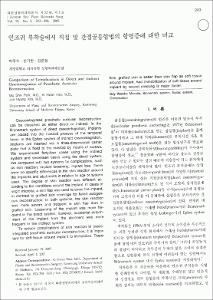KUMEL Repository
1. Journal Papers (연구논문)
1. School of Medicine (의과대학)
Dept. of Plastic Surgery (성형외과학)
인조귀 부착술에서 직접 및 간접골통합법의 합병증에 대한 비교
- Keimyung Author(s)
- Park, Mu Sik; Han, Ki Hwan; Kim, Jun Hyung
- Department
- Dept. of Plastic Surgery (성형외과학)
- Journal Title
- 대한성형외과학회지
- Issued Date
- 2005
- Volume
- 32
- Issue
- 3
- Abstract
- Osseointegrated prosthetic auricular reconstruction can be classified as either direct or indirect. In the Branemark system of direct osseointegration, implants are placed into the mastoid process of the temporal bone. In the Epitec system of indirect osseointegration, implants are inserted into a three-dimensional carrier plate that is fixed to the mastoid by means of screws. We experienced forty-four cases using the indirect system and seventeen cases using the direct system. We compared with two systems by complications, such as skin reaction, implant loosening, implant loss. There were no specific differences in the skin reaction around the implants and abutments in relation to age or system used. The degree of skin reaction was different according to the conditions around the implant: in cases of virgin microtia, a skin flap was used to cover the implant, in contrast to grafted skin coverage for failed autogenous reconstruction. In both systems, the skin reaction was more severe and frequent in skin flap than in grafted skin. Loosening of the implant was more frequent in the direct system; however, accidental detachment of the implant from the abutment was more frequent in the indirect system. To reduce complications of skin reaction in osseointegrated prosthetic auricular reconstruction, it is important for soft tissue around implant to immobilize. Therefore, grafted skin is better than skin flap as soft tissue around implant. And immobilization of soft tissue around implant by wound dressing is major facter.
- Alternative Title
- Comparison of Complications in Direct and Indirect Osseointegration of Prosthetic Auricular Reconstruction
- Publisher
- School of Medicine
- Citation
- 박무식 et al. (2005). 인조귀 부착술에서 직접 및 간접골통합법의 합병증에 대한 비교. 대한성형외과학회지, 32(3), 293–298.
- Type
- Article
- ISSN
- 1015-6402
- Appears in Collections:
- 1. School of Medicine (의과대학) > Dept. of Plastic Surgery (성형외과학)
- 파일 목록
-
-
Download
 oak-bbb-2090.pdf
기타 데이터 / 1.79 MB / Adobe PDF
oak-bbb-2090.pdf
기타 데이터 / 1.79 MB / Adobe PDF
-
Items in Repository are protected by copyright, with all rights reserved, unless otherwise indicated.